Evaluation of Leadership and Management at Sainsbury's: A Report
VerifiedAdded on 2023/01/05
|14
|3424
|25
Report
AI Summary
This report provides a critical evaluation of the effectiveness of management and leadership skills within Sainsbury's. It begins with an introduction to organizational management and leadership, followed by an analysis of contemporary leadership theories, including participative, situational, transformative, Vroom-Yetton, and autocratic leadership styles. The report also examines contemporary management theories such as scientific, systems, and contingency management, as well as Theory X and Theory Y. Key performance metrics like revenue per customer, gross profit margin, and organizational sales are discussed. The analysis then focuses on the significance of leadership and management performance in achieving organizational goals, with a tabular representation of their roles. The report concludes by emphasizing the collaborative nature of leadership and management, and their combined impact on improving Sainsbury's performance by motivating employees and fostering a self-development mindset.
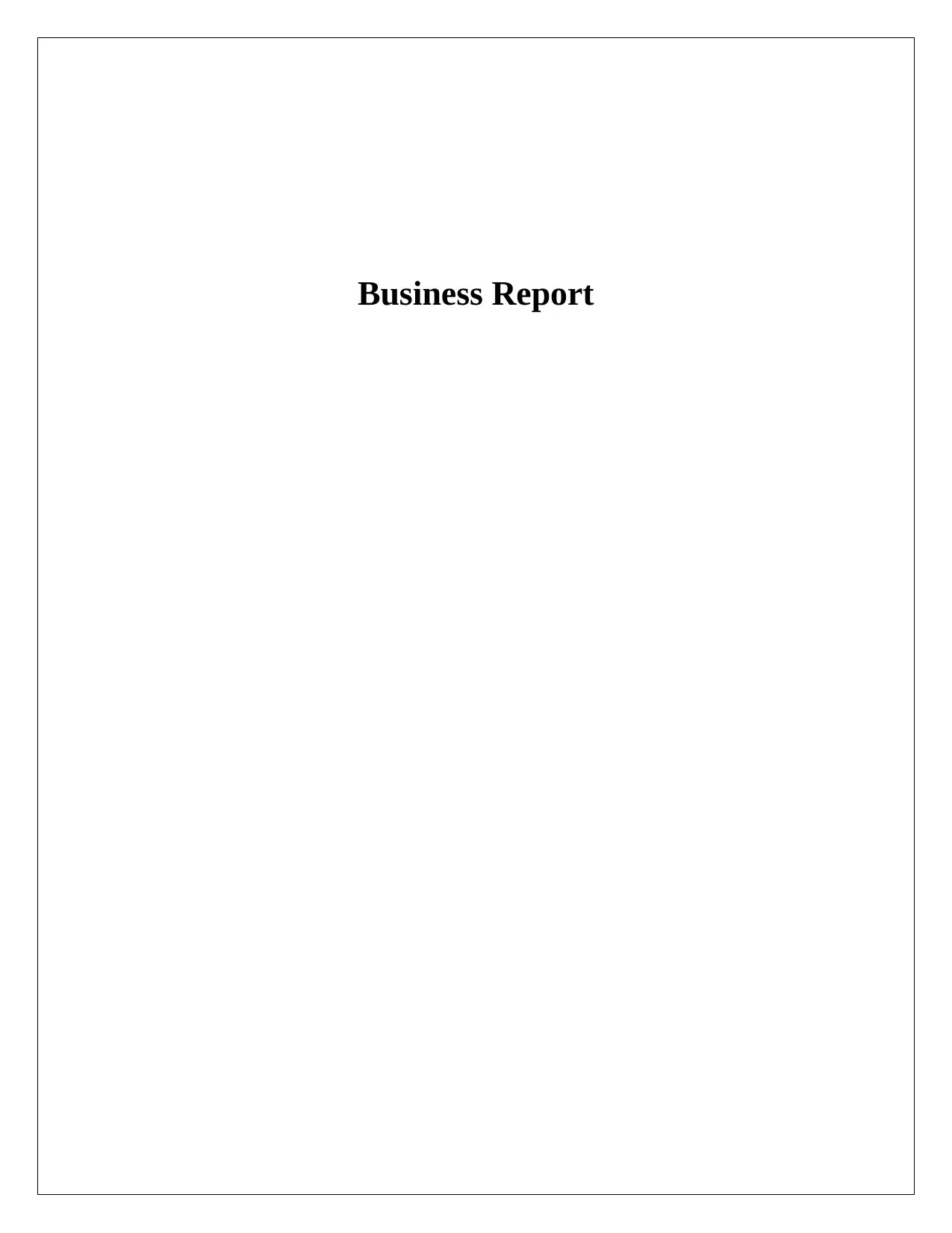
Business Report
Paraphrase This Document
Need a fresh take? Get an instant paraphrase of this document with our AI Paraphraser
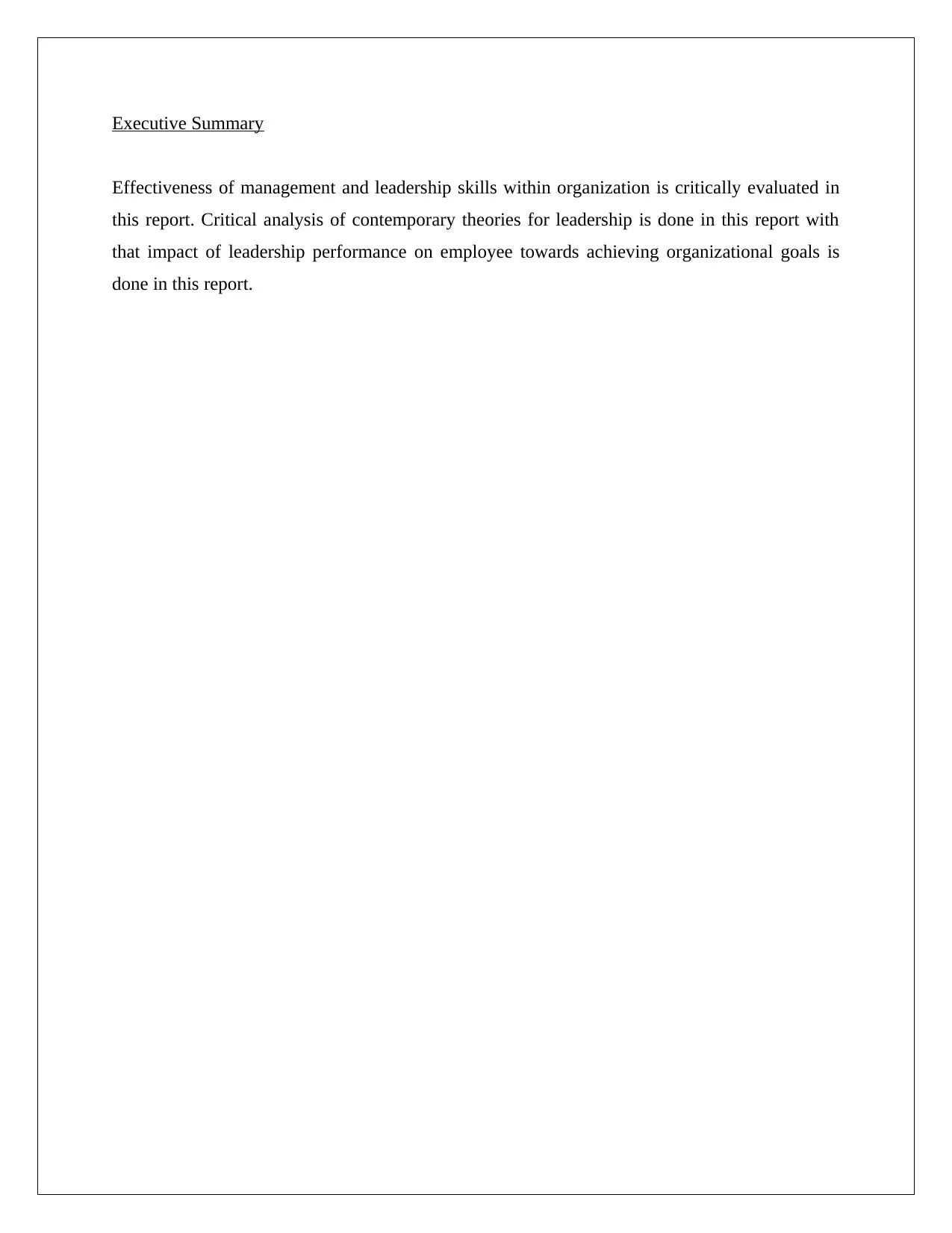
Executive Summary
Effectiveness of management and leadership skills within organization is critically evaluated in
this report. Critical analysis of contemporary theories for leadership is done in this report with
that impact of leadership performance on employee towards achieving organizational goals is
done in this report.
Effectiveness of management and leadership skills within organization is critically evaluated in
this report. Critical analysis of contemporary theories for leadership is done in this report with
that impact of leadership performance on employee towards achieving organizational goals is
done in this report.
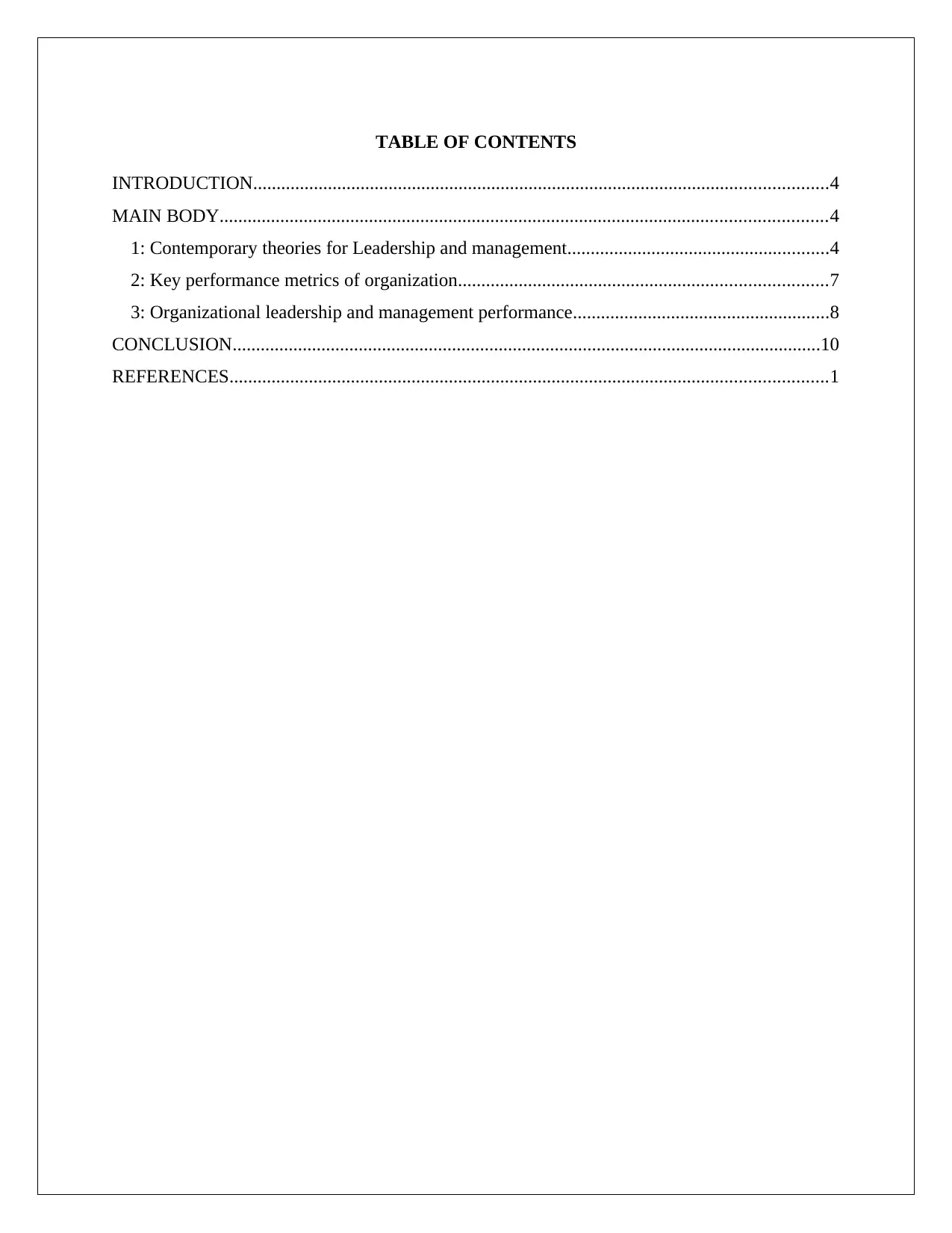
TABLE OF CONTENTS
INTRODUCTION...........................................................................................................................4
MAIN BODY..................................................................................................................................4
1: Contemporary theories for Leadership and management........................................................4
2: Key performance metrics of organization...............................................................................7
3: Organizational leadership and management performance.......................................................8
CONCLUSION..............................................................................................................................10
REFERENCES................................................................................................................................1
INTRODUCTION...........................................................................................................................4
MAIN BODY..................................................................................................................................4
1: Contemporary theories for Leadership and management........................................................4
2: Key performance metrics of organization...............................................................................7
3: Organizational leadership and management performance.......................................................8
CONCLUSION..............................................................................................................................10
REFERENCES................................................................................................................................1
⊘ This is a preview!⊘
Do you want full access?
Subscribe today to unlock all pages.

Trusted by 1+ million students worldwide
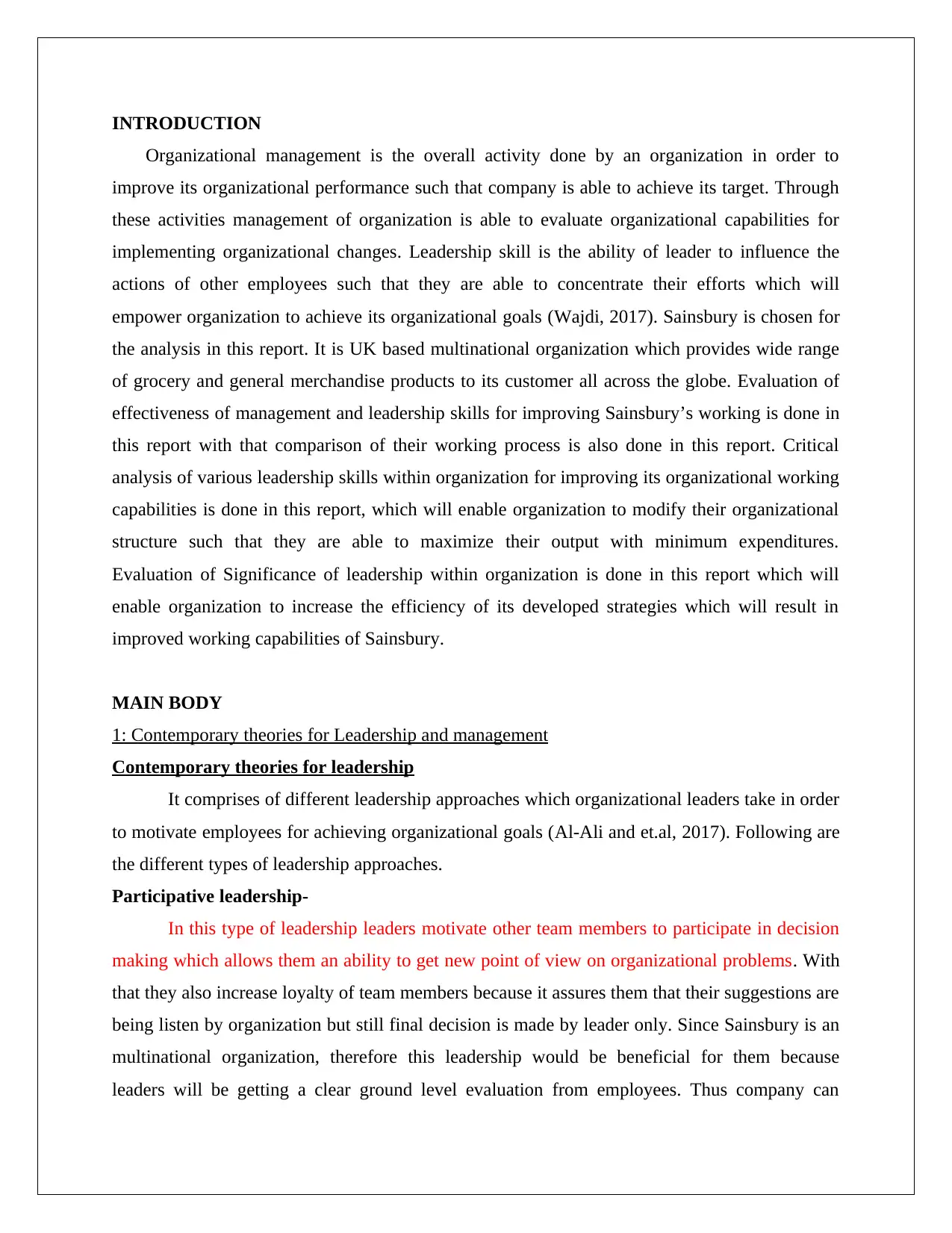
INTRODUCTION
Organizational management is the overall activity done by an organization in order to
improve its organizational performance such that company is able to achieve its target. Through
these activities management of organization is able to evaluate organizational capabilities for
implementing organizational changes. Leadership skill is the ability of leader to influence the
actions of other employees such that they are able to concentrate their efforts which will
empower organization to achieve its organizational goals (Wajdi, 2017). Sainsbury is chosen for
the analysis in this report. It is UK based multinational organization which provides wide range
of grocery and general merchandise products to its customer all across the globe. Evaluation of
effectiveness of management and leadership skills for improving Sainsbury’s working is done in
this report with that comparison of their working process is also done in this report. Critical
analysis of various leadership skills within organization for improving its organizational working
capabilities is done in this report, which will enable organization to modify their organizational
structure such that they are able to maximize their output with minimum expenditures.
Evaluation of Significance of leadership within organization is done in this report which will
enable organization to increase the efficiency of its developed strategies which will result in
improved working capabilities of Sainsbury.
MAIN BODY
1: Contemporary theories for Leadership and management
Contemporary theories for leadership
It comprises of different leadership approaches which organizational leaders take in order
to motivate employees for achieving organizational goals (Al-Ali and et.al, 2017). Following are
the different types of leadership approaches.
Participative leadership-
In this type of leadership leaders motivate other team members to participate in decision
making which allows them an ability to get new point of view on organizational problems. With
that they also increase loyalty of team members because it assures them that their suggestions are
being listen by organization but still final decision is made by leader only. Since Sainsbury is an
multinational organization, therefore this leadership would be beneficial for them because
leaders will be getting a clear ground level evaluation from employees. Thus company can
Organizational management is the overall activity done by an organization in order to
improve its organizational performance such that company is able to achieve its target. Through
these activities management of organization is able to evaluate organizational capabilities for
implementing organizational changes. Leadership skill is the ability of leader to influence the
actions of other employees such that they are able to concentrate their efforts which will
empower organization to achieve its organizational goals (Wajdi, 2017). Sainsbury is chosen for
the analysis in this report. It is UK based multinational organization which provides wide range
of grocery and general merchandise products to its customer all across the globe. Evaluation of
effectiveness of management and leadership skills for improving Sainsbury’s working is done in
this report with that comparison of their working process is also done in this report. Critical
analysis of various leadership skills within organization for improving its organizational working
capabilities is done in this report, which will enable organization to modify their organizational
structure such that they are able to maximize their output with minimum expenditures.
Evaluation of Significance of leadership within organization is done in this report which will
enable organization to increase the efficiency of its developed strategies which will result in
improved working capabilities of Sainsbury.
MAIN BODY
1: Contemporary theories for Leadership and management
Contemporary theories for leadership
It comprises of different leadership approaches which organizational leaders take in order
to motivate employees for achieving organizational goals (Al-Ali and et.al, 2017). Following are
the different types of leadership approaches.
Participative leadership-
In this type of leadership leaders motivate other team members to participate in decision
making which allows them an ability to get new point of view on organizational problems. With
that they also increase loyalty of team members because it assures them that their suggestions are
being listen by organization but still final decision is made by leader only. Since Sainsbury is an
multinational organization, therefore this leadership would be beneficial for them because
leaders will be getting a clear ground level evaluation from employees. Thus company can
Paraphrase This Document
Need a fresh take? Get an instant paraphrase of this document with our AI Paraphraser
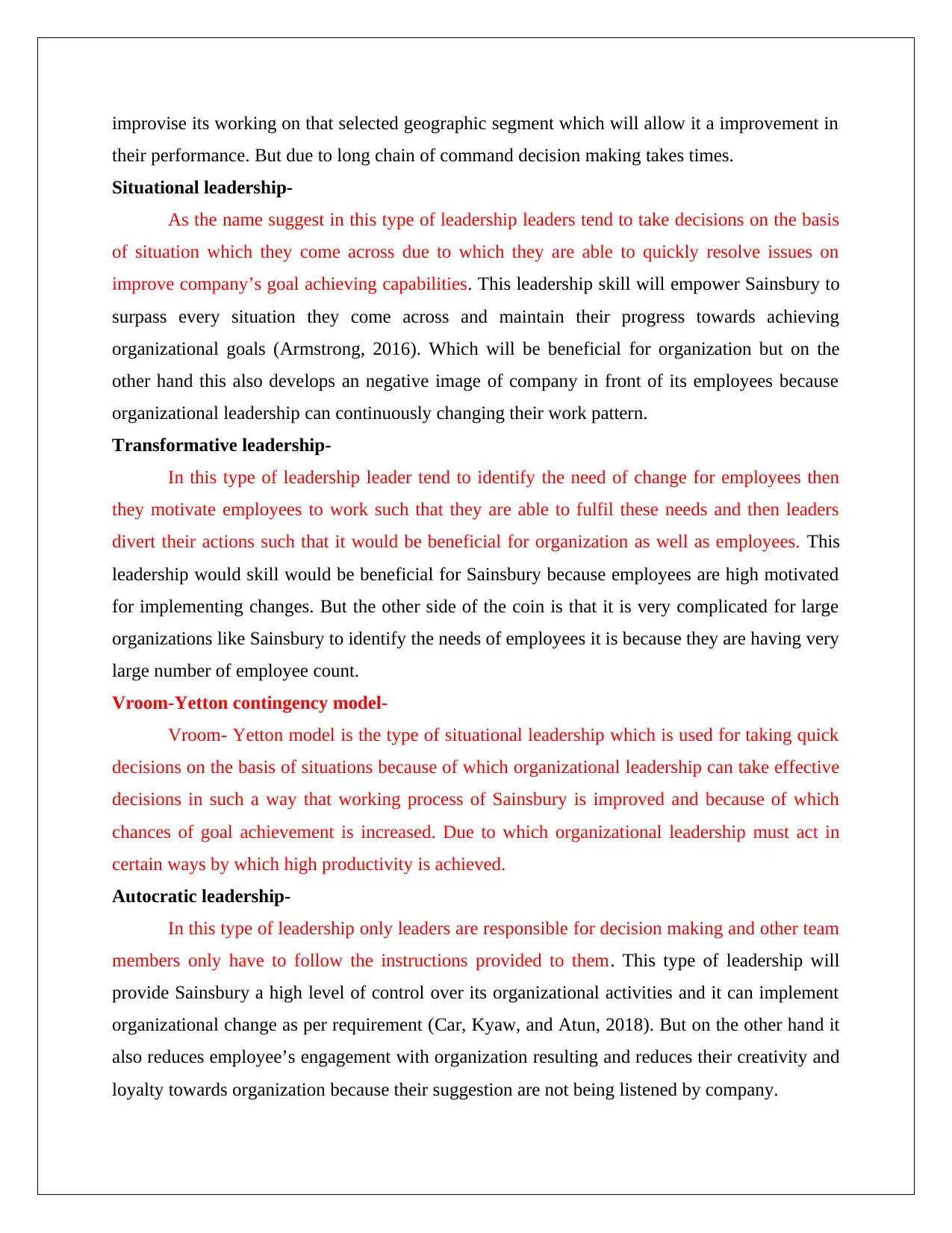
improvise its working on that selected geographic segment which will allow it a improvement in
their performance. But due to long chain of command decision making takes times.
Situational leadership-
As the name suggest in this type of leadership leaders tend to take decisions on the basis
of situation which they come across due to which they are able to quickly resolve issues on
improve company’s goal achieving capabilities. This leadership skill will empower Sainsbury to
surpass every situation they come across and maintain their progress towards achieving
organizational goals (Armstrong, 2016). Which will be beneficial for organization but on the
other hand this also develops an negative image of company in front of its employees because
organizational leadership can continuously changing their work pattern.
Transformative leadership-
In this type of leadership leader tend to identify the need of change for employees then
they motivate employees to work such that they are able to fulfil these needs and then leaders
divert their actions such that it would be beneficial for organization as well as employees. This
leadership would skill would be beneficial for Sainsbury because employees are high motivated
for implementing changes. But the other side of the coin is that it is very complicated for large
organizations like Sainsbury to identify the needs of employees it is because they are having very
large number of employee count.
Vroom-Yetton contingency model-
Vroom- Yetton model is the type of situational leadership which is used for taking quick
decisions on the basis of situations because of which organizational leadership can take effective
decisions in such a way that working process of Sainsbury is improved and because of which
chances of goal achievement is increased. Due to which organizational leadership must act in
certain ways by which high productivity is achieved.
Autocratic leadership-
In this type of leadership only leaders are responsible for decision making and other team
members only have to follow the instructions provided to them. This type of leadership will
provide Sainsbury a high level of control over its organizational activities and it can implement
organizational change as per requirement (Car, Kyaw, and Atun, 2018). But on the other hand it
also reduces employee’s engagement with organization resulting and reduces their creativity and
loyalty towards organization because their suggestion are not being listened by company.
their performance. But due to long chain of command decision making takes times.
Situational leadership-
As the name suggest in this type of leadership leaders tend to take decisions on the basis
of situation which they come across due to which they are able to quickly resolve issues on
improve company’s goal achieving capabilities. This leadership skill will empower Sainsbury to
surpass every situation they come across and maintain their progress towards achieving
organizational goals (Armstrong, 2016). Which will be beneficial for organization but on the
other hand this also develops an negative image of company in front of its employees because
organizational leadership can continuously changing their work pattern.
Transformative leadership-
In this type of leadership leader tend to identify the need of change for employees then
they motivate employees to work such that they are able to fulfil these needs and then leaders
divert their actions such that it would be beneficial for organization as well as employees. This
leadership would skill would be beneficial for Sainsbury because employees are high motivated
for implementing changes. But the other side of the coin is that it is very complicated for large
organizations like Sainsbury to identify the needs of employees it is because they are having very
large number of employee count.
Vroom-Yetton contingency model-
Vroom- Yetton model is the type of situational leadership which is used for taking quick
decisions on the basis of situations because of which organizational leadership can take effective
decisions in such a way that working process of Sainsbury is improved and because of which
chances of goal achievement is increased. Due to which organizational leadership must act in
certain ways by which high productivity is achieved.
Autocratic leadership-
In this type of leadership only leaders are responsible for decision making and other team
members only have to follow the instructions provided to them. This type of leadership will
provide Sainsbury a high level of control over its organizational activities and it can implement
organizational change as per requirement (Car, Kyaw, and Atun, 2018). But on the other hand it
also reduces employee’s engagement with organization resulting and reduces their creativity and
loyalty towards organization because their suggestion are not being listened by company.
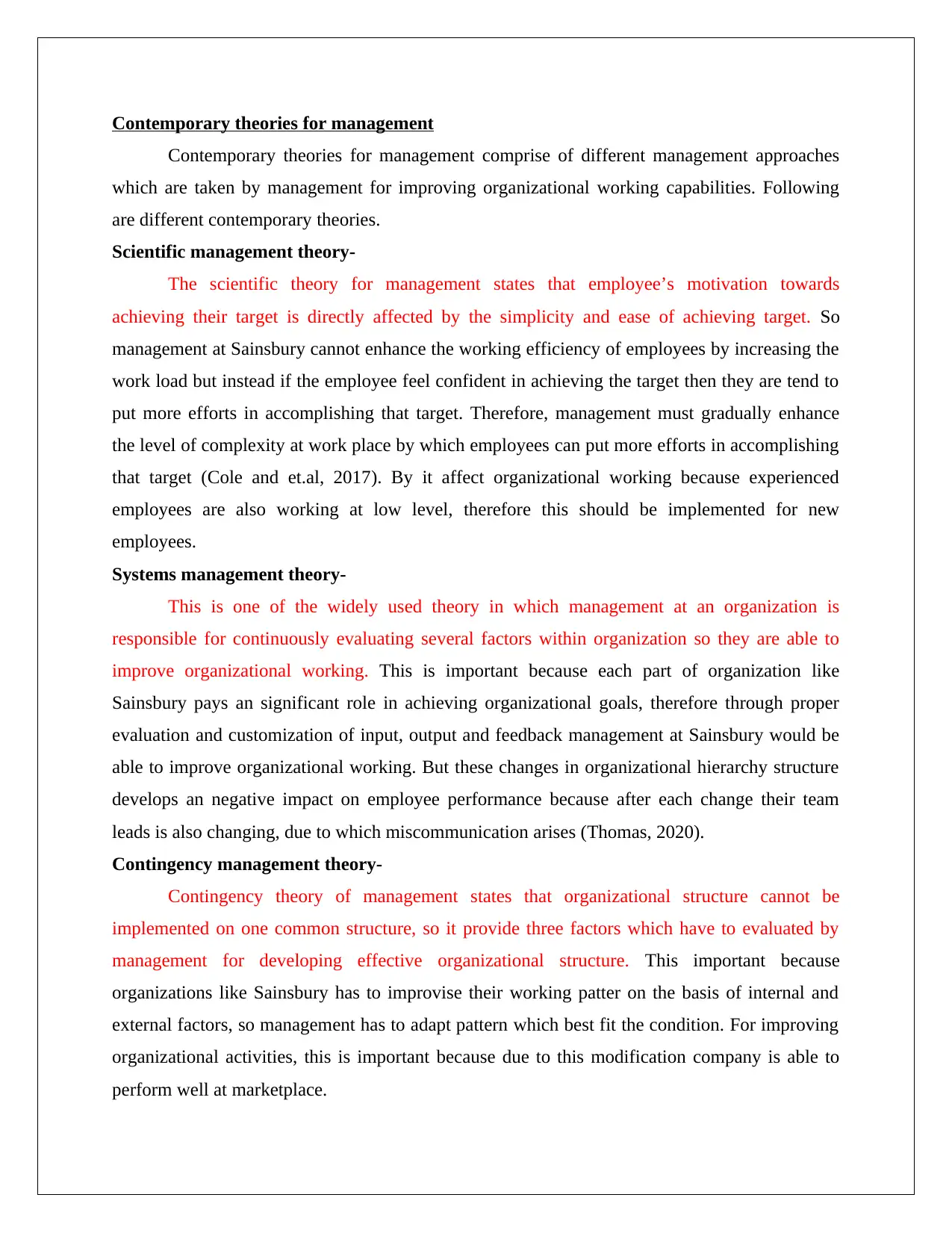
Contemporary theories for management
Contemporary theories for management comprise of different management approaches
which are taken by management for improving organizational working capabilities. Following
are different contemporary theories.
Scientific management theory-
The scientific theory for management states that employee’s motivation towards
achieving their target is directly affected by the simplicity and ease of achieving target. So
management at Sainsbury cannot enhance the working efficiency of employees by increasing the
work load but instead if the employee feel confident in achieving the target then they are tend to
put more efforts in accomplishing that target. Therefore, management must gradually enhance
the level of complexity at work place by which employees can put more efforts in accomplishing
that target (Cole and et.al, 2017). By it affect organizational working because experienced
employees are also working at low level, therefore this should be implemented for new
employees.
Systems management theory-
This is one of the widely used theory in which management at an organization is
responsible for continuously evaluating several factors within organization so they are able to
improve organizational working. This is important because each part of organization like
Sainsbury pays an significant role in achieving organizational goals, therefore through proper
evaluation and customization of input, output and feedback management at Sainsbury would be
able to improve organizational working. But these changes in organizational hierarchy structure
develops an negative impact on employee performance because after each change their team
leads is also changing, due to which miscommunication arises (Thomas, 2020).
Contingency management theory-
Contingency theory of management states that organizational structure cannot be
implemented on one common structure, so it provide three factors which have to evaluated by
management for developing effective organizational structure. This important because
organizations like Sainsbury has to improvise their working patter on the basis of internal and
external factors, so management has to adapt pattern which best fit the condition. For improving
organizational activities, this is important because due to this modification company is able to
perform well at marketplace.
Contemporary theories for management comprise of different management approaches
which are taken by management for improving organizational working capabilities. Following
are different contemporary theories.
Scientific management theory-
The scientific theory for management states that employee’s motivation towards
achieving their target is directly affected by the simplicity and ease of achieving target. So
management at Sainsbury cannot enhance the working efficiency of employees by increasing the
work load but instead if the employee feel confident in achieving the target then they are tend to
put more efforts in accomplishing that target. Therefore, management must gradually enhance
the level of complexity at work place by which employees can put more efforts in accomplishing
that target (Cole and et.al, 2017). By it affect organizational working because experienced
employees are also working at low level, therefore this should be implemented for new
employees.
Systems management theory-
This is one of the widely used theory in which management at an organization is
responsible for continuously evaluating several factors within organization so they are able to
improve organizational working. This is important because each part of organization like
Sainsbury pays an significant role in achieving organizational goals, therefore through proper
evaluation and customization of input, output and feedback management at Sainsbury would be
able to improve organizational working. But these changes in organizational hierarchy structure
develops an negative impact on employee performance because after each change their team
leads is also changing, due to which miscommunication arises (Thomas, 2020).
Contingency management theory-
Contingency theory of management states that organizational structure cannot be
implemented on one common structure, so it provide three factors which have to evaluated by
management for developing effective organizational structure. This important because
organizations like Sainsbury has to improvise their working patter on the basis of internal and
external factors, so management has to adapt pattern which best fit the condition. For improving
organizational activities, this is important because due to this modification company is able to
perform well at marketplace.
⊘ This is a preview!⊘
Do you want full access?
Subscribe today to unlock all pages.

Trusted by 1+ million students worldwide
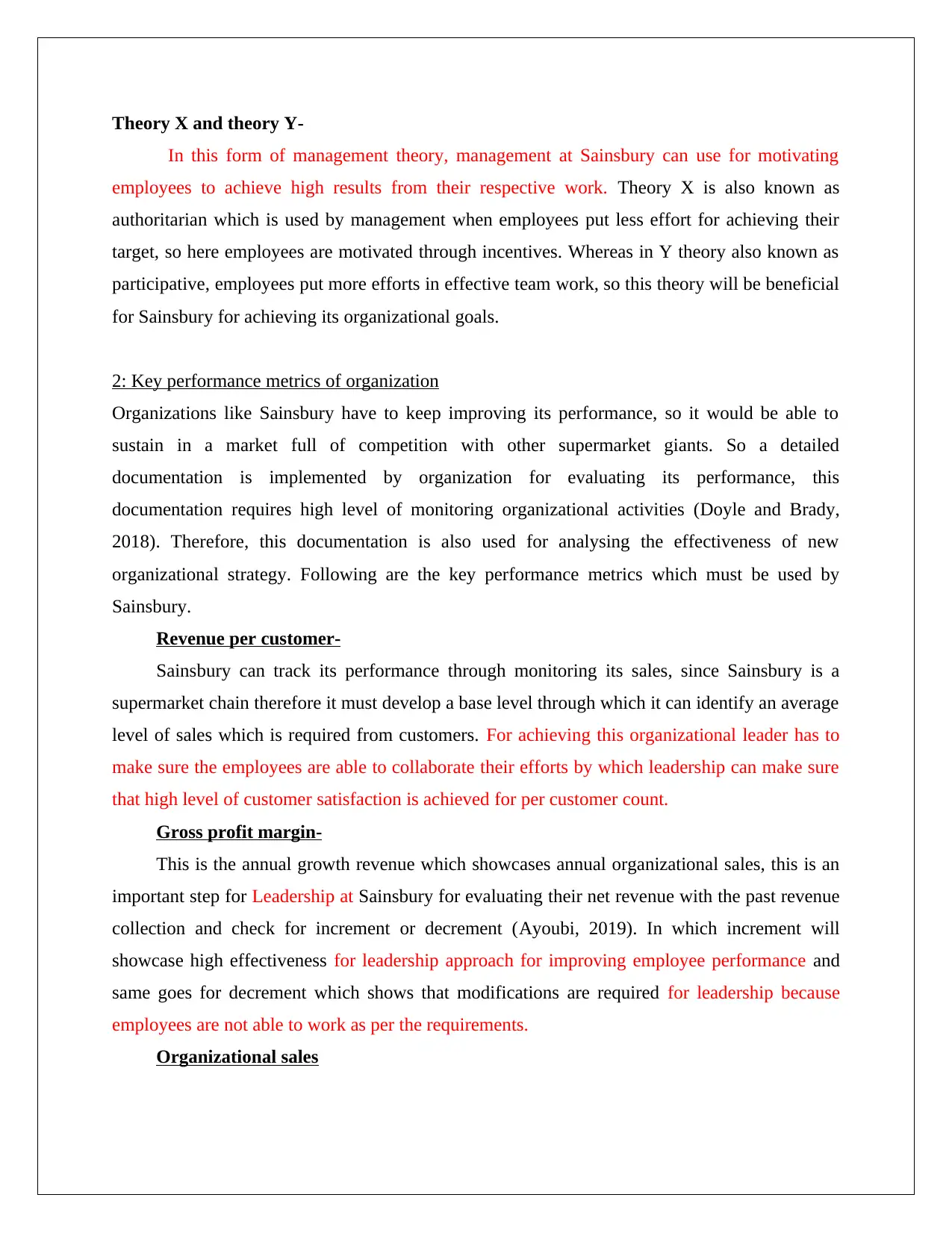
Theory X and theory Y-
In this form of management theory, management at Sainsbury can use for motivating
employees to achieve high results from their respective work. Theory X is also known as
authoritarian which is used by management when employees put less effort for achieving their
target, so here employees are motivated through incentives. Whereas in Y theory also known as
participative, employees put more efforts in effective team work, so this theory will be beneficial
for Sainsbury for achieving its organizational goals.
2: Key performance metrics of organization
Organizations like Sainsbury have to keep improving its performance, so it would be able to
sustain in a market full of competition with other supermarket giants. So a detailed
documentation is implemented by organization for evaluating its performance, this
documentation requires high level of monitoring organizational activities (Doyle and Brady,
2018). Therefore, this documentation is also used for analysing the effectiveness of new
organizational strategy. Following are the key performance metrics which must be used by
Sainsbury.
Revenue per customer-
Sainsbury can track its performance through monitoring its sales, since Sainsbury is a
supermarket chain therefore it must develop a base level through which it can identify an average
level of sales which is required from customers. For achieving this organizational leader has to
make sure the employees are able to collaborate their efforts by which leadership can make sure
that high level of customer satisfaction is achieved for per customer count.
Gross profit margin-
This is the annual growth revenue which showcases annual organizational sales, this is an
important step for Leadership at Sainsbury for evaluating their net revenue with the past revenue
collection and check for increment or decrement (Ayoubi, 2019). In which increment will
showcase high effectiveness for leadership approach for improving employee performance and
same goes for decrement which shows that modifications are required for leadership because
employees are not able to work as per the requirements.
Organizational sales
In this form of management theory, management at Sainsbury can use for motivating
employees to achieve high results from their respective work. Theory X is also known as
authoritarian which is used by management when employees put less effort for achieving their
target, so here employees are motivated through incentives. Whereas in Y theory also known as
participative, employees put more efforts in effective team work, so this theory will be beneficial
for Sainsbury for achieving its organizational goals.
2: Key performance metrics of organization
Organizations like Sainsbury have to keep improving its performance, so it would be able to
sustain in a market full of competition with other supermarket giants. So a detailed
documentation is implemented by organization for evaluating its performance, this
documentation requires high level of monitoring organizational activities (Doyle and Brady,
2018). Therefore, this documentation is also used for analysing the effectiveness of new
organizational strategy. Following are the key performance metrics which must be used by
Sainsbury.
Revenue per customer-
Sainsbury can track its performance through monitoring its sales, since Sainsbury is a
supermarket chain therefore it must develop a base level through which it can identify an average
level of sales which is required from customers. For achieving this organizational leader has to
make sure the employees are able to collaborate their efforts by which leadership can make sure
that high level of customer satisfaction is achieved for per customer count.
Gross profit margin-
This is the annual growth revenue which showcases annual organizational sales, this is an
important step for Leadership at Sainsbury for evaluating their net revenue with the past revenue
collection and check for increment or decrement (Ayoubi, 2019). In which increment will
showcase high effectiveness for leadership approach for improving employee performance and
same goes for decrement which shows that modifications are required for leadership because
employees are not able to work as per the requirements.
Organizational sales
Paraphrase This Document
Need a fresh take? Get an instant paraphrase of this document with our AI Paraphraser
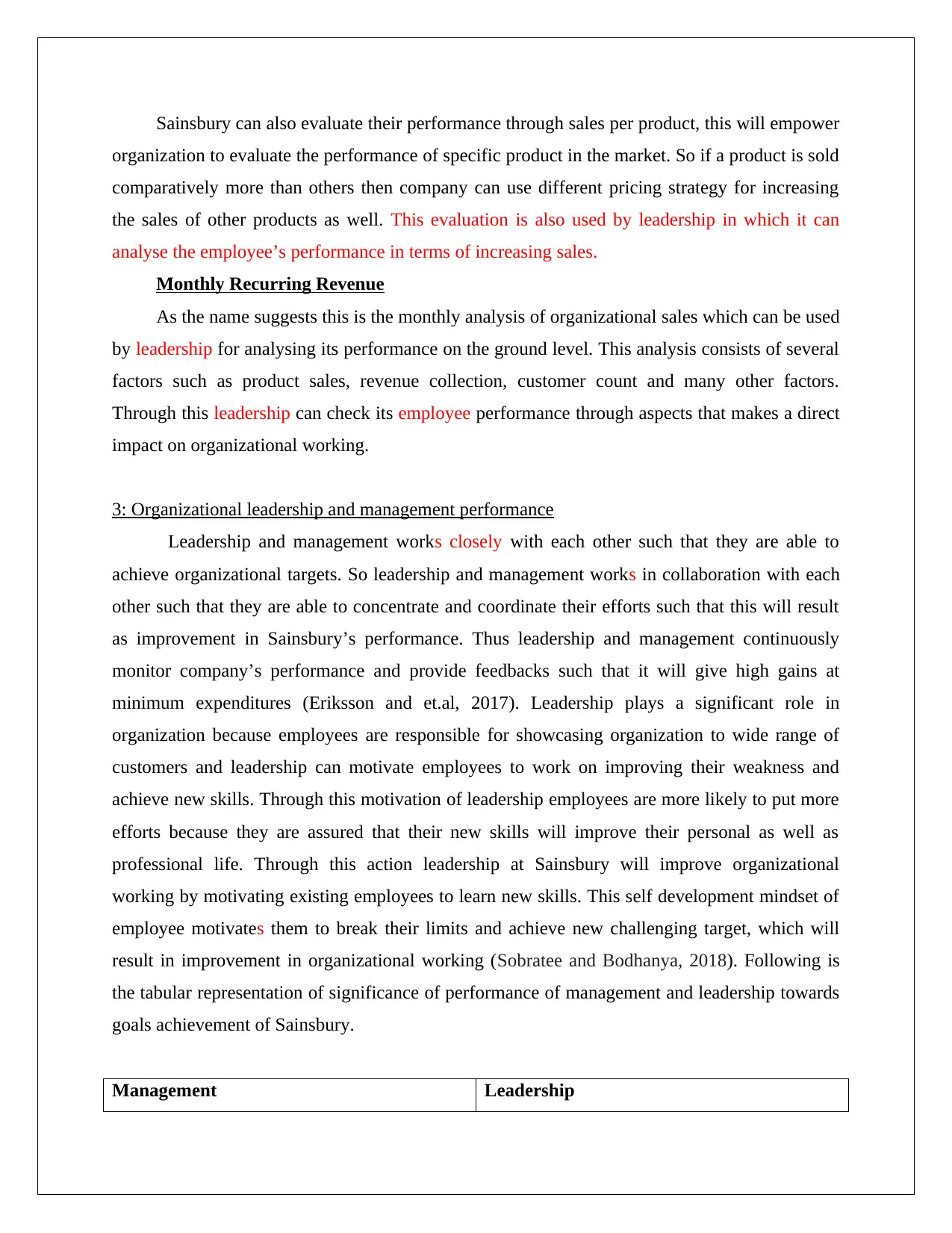
Sainsbury can also evaluate their performance through sales per product, this will empower
organization to evaluate the performance of specific product in the market. So if a product is sold
comparatively more than others then company can use different pricing strategy for increasing
the sales of other products as well. This evaluation is also used by leadership in which it can
analyse the employee’s performance in terms of increasing sales.
Monthly Recurring Revenue
As the name suggests this is the monthly analysis of organizational sales which can be used
by leadership for analysing its performance on the ground level. This analysis consists of several
factors such as product sales, revenue collection, customer count and many other factors.
Through this leadership can check its employee performance through aspects that makes a direct
impact on organizational working.
3: Organizational leadership and management performance
Leadership and management works closely with each other such that they are able to
achieve organizational targets. So leadership and management works in collaboration with each
other such that they are able to concentrate and coordinate their efforts such that this will result
as improvement in Sainsbury’s performance. Thus leadership and management continuously
monitor company’s performance and provide feedbacks such that it will give high gains at
minimum expenditures (Eriksson and et.al, 2017). Leadership plays a significant role in
organization because employees are responsible for showcasing organization to wide range of
customers and leadership can motivate employees to work on improving their weakness and
achieve new skills. Through this motivation of leadership employees are more likely to put more
efforts because they are assured that their new skills will improve their personal as well as
professional life. Through this action leadership at Sainsbury will improve organizational
working by motivating existing employees to learn new skills. This self development mindset of
employee motivates them to break their limits and achieve new challenging target, which will
result in improvement in organizational working (Sobratee and Bodhanya, 2018). Following is
the tabular representation of significance of performance of management and leadership towards
goals achievement of Sainsbury.
Management Leadership
organization to evaluate the performance of specific product in the market. So if a product is sold
comparatively more than others then company can use different pricing strategy for increasing
the sales of other products as well. This evaluation is also used by leadership in which it can
analyse the employee’s performance in terms of increasing sales.
Monthly Recurring Revenue
As the name suggests this is the monthly analysis of organizational sales which can be used
by leadership for analysing its performance on the ground level. This analysis consists of several
factors such as product sales, revenue collection, customer count and many other factors.
Through this leadership can check its employee performance through aspects that makes a direct
impact on organizational working.
3: Organizational leadership and management performance
Leadership and management works closely with each other such that they are able to
achieve organizational targets. So leadership and management works in collaboration with each
other such that they are able to concentrate and coordinate their efforts such that this will result
as improvement in Sainsbury’s performance. Thus leadership and management continuously
monitor company’s performance and provide feedbacks such that it will give high gains at
minimum expenditures (Eriksson and et.al, 2017). Leadership plays a significant role in
organization because employees are responsible for showcasing organization to wide range of
customers and leadership can motivate employees to work on improving their weakness and
achieve new skills. Through this motivation of leadership employees are more likely to put more
efforts because they are assured that their new skills will improve their personal as well as
professional life. Through this action leadership at Sainsbury will improve organizational
working by motivating existing employees to learn new skills. This self development mindset of
employee motivates them to break their limits and achieve new challenging target, which will
result in improvement in organizational working (Sobratee and Bodhanya, 2018). Following is
the tabular representation of significance of performance of management and leadership towards
goals achievement of Sainsbury.
Management Leadership
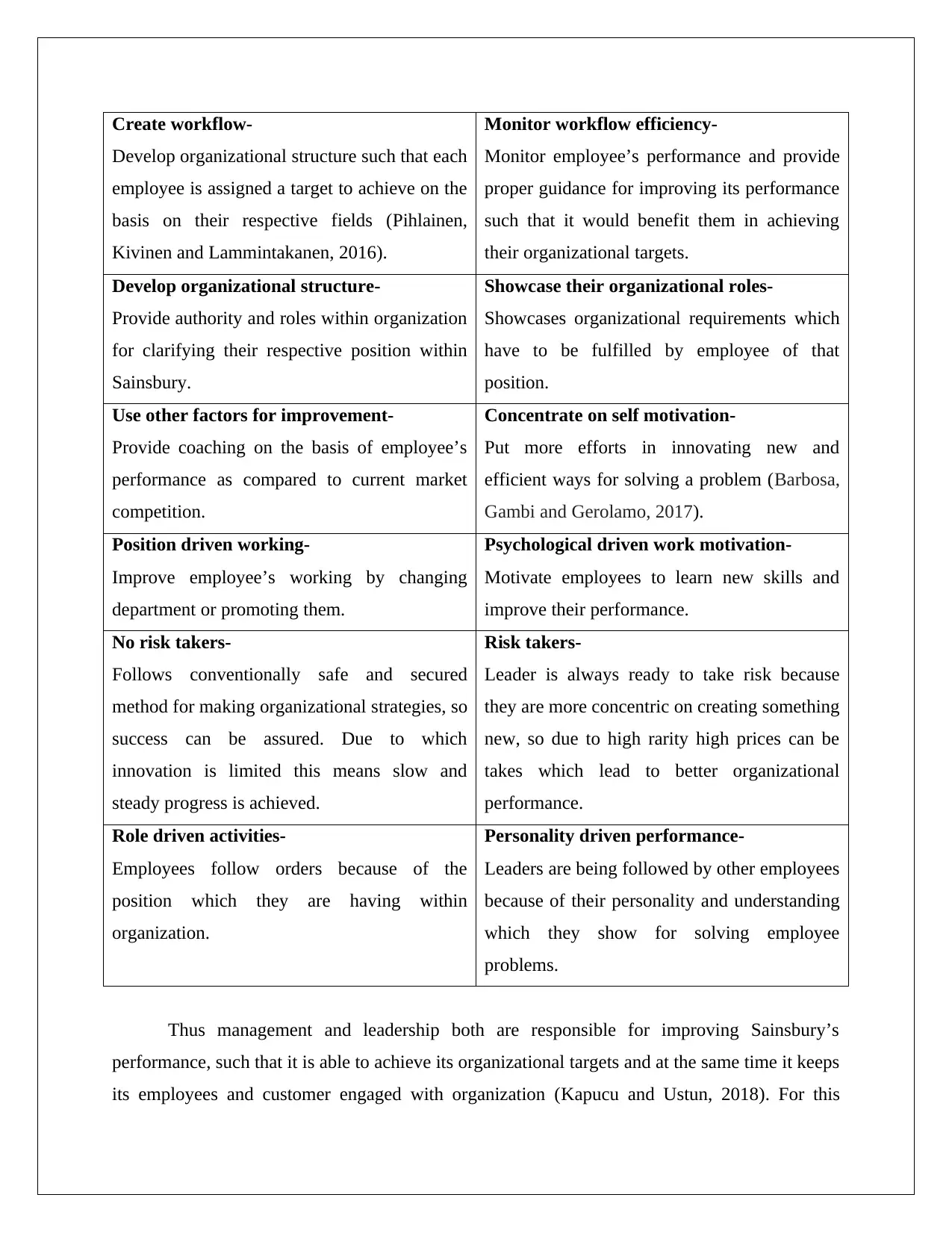
Create workflow-
Develop organizational structure such that each
employee is assigned a target to achieve on the
basis on their respective fields (Pihlainen,
Kivinen and Lammintakanen, 2016).
Monitor workflow efficiency-
Monitor employee’s performance and provide
proper guidance for improving its performance
such that it would benefit them in achieving
their organizational targets.
Develop organizational structure-
Provide authority and roles within organization
for clarifying their respective position within
Sainsbury.
Showcase their organizational roles-
Showcases organizational requirements which
have to be fulfilled by employee of that
position.
Use other factors for improvement-
Provide coaching on the basis of employee’s
performance as compared to current market
competition.
Concentrate on self motivation-
Put more efforts in innovating new and
efficient ways for solving a problem (Barbosa,
Gambi and Gerolamo, 2017).
Position driven working-
Improve employee’s working by changing
department or promoting them.
Psychological driven work motivation-
Motivate employees to learn new skills and
improve their performance.
No risk takers-
Follows conventionally safe and secured
method for making organizational strategies, so
success can be assured. Due to which
innovation is limited this means slow and
steady progress is achieved.
Risk takers-
Leader is always ready to take risk because
they are more concentric on creating something
new, so due to high rarity high prices can be
takes which lead to better organizational
performance.
Role driven activities-
Employees follow orders because of the
position which they are having within
organization.
Personality driven performance-
Leaders are being followed by other employees
because of their personality and understanding
which they show for solving employee
problems.
Thus management and leadership both are responsible for improving Sainsbury’s
performance, such that it is able to achieve its organizational targets and at the same time it keeps
its employees and customer engaged with organization (Kapucu and Ustun, 2018). For this
Develop organizational structure such that each
employee is assigned a target to achieve on the
basis on their respective fields (Pihlainen,
Kivinen and Lammintakanen, 2016).
Monitor workflow efficiency-
Monitor employee’s performance and provide
proper guidance for improving its performance
such that it would benefit them in achieving
their organizational targets.
Develop organizational structure-
Provide authority and roles within organization
for clarifying their respective position within
Sainsbury.
Showcase their organizational roles-
Showcases organizational requirements which
have to be fulfilled by employee of that
position.
Use other factors for improvement-
Provide coaching on the basis of employee’s
performance as compared to current market
competition.
Concentrate on self motivation-
Put more efforts in innovating new and
efficient ways for solving a problem (Barbosa,
Gambi and Gerolamo, 2017).
Position driven working-
Improve employee’s working by changing
department or promoting them.
Psychological driven work motivation-
Motivate employees to learn new skills and
improve their performance.
No risk takers-
Follows conventionally safe and secured
method for making organizational strategies, so
success can be assured. Due to which
innovation is limited this means slow and
steady progress is achieved.
Risk takers-
Leader is always ready to take risk because
they are more concentric on creating something
new, so due to high rarity high prices can be
takes which lead to better organizational
performance.
Role driven activities-
Employees follow orders because of the
position which they are having within
organization.
Personality driven performance-
Leaders are being followed by other employees
because of their personality and understanding
which they show for solving employee
problems.
Thus management and leadership both are responsible for improving Sainsbury’s
performance, such that it is able to achieve its organizational targets and at the same time it keeps
its employees and customer engaged with organization (Kapucu and Ustun, 2018). For this
⊘ This is a preview!⊘
Do you want full access?
Subscribe today to unlock all pages.

Trusted by 1+ million students worldwide
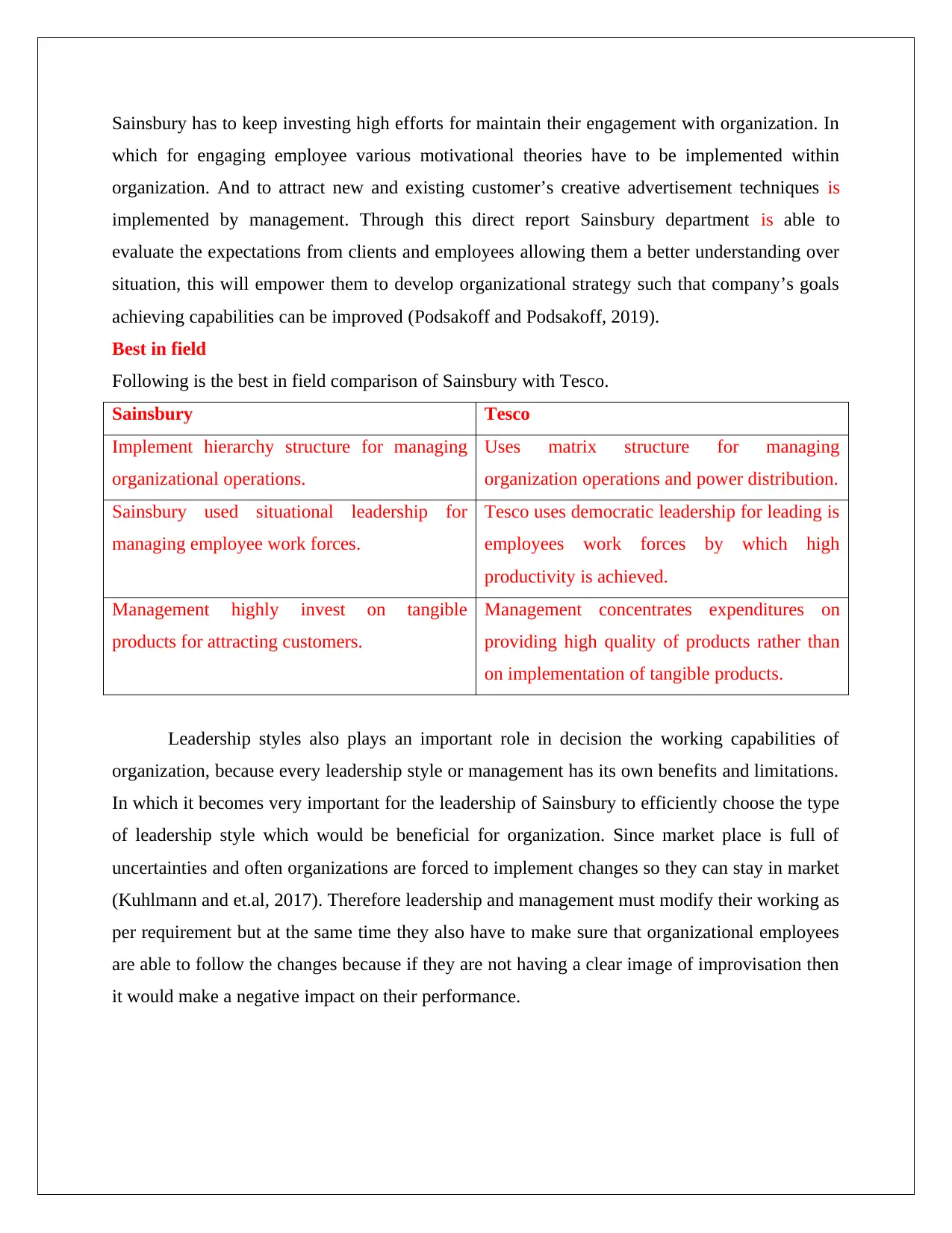
Sainsbury has to keep investing high efforts for maintain their engagement with organization. In
which for engaging employee various motivational theories have to be implemented within
organization. And to attract new and existing customer’s creative advertisement techniques is
implemented by management. Through this direct report Sainsbury department is able to
evaluate the expectations from clients and employees allowing them a better understanding over
situation, this will empower them to develop organizational strategy such that company’s goals
achieving capabilities can be improved (Podsakoff and Podsakoff, 2019).
Best in field
Following is the best in field comparison of Sainsbury with Tesco.
Sainsbury Tesco
Implement hierarchy structure for managing
organizational operations.
Uses matrix structure for managing
organization operations and power distribution.
Sainsbury used situational leadership for
managing employee work forces.
Tesco uses democratic leadership for leading is
employees work forces by which high
productivity is achieved.
Management highly invest on tangible
products for attracting customers.
Management concentrates expenditures on
providing high quality of products rather than
on implementation of tangible products.
Leadership styles also plays an important role in decision the working capabilities of
organization, because every leadership style or management has its own benefits and limitations.
In which it becomes very important for the leadership of Sainsbury to efficiently choose the type
of leadership style which would be beneficial for organization. Since market place is full of
uncertainties and often organizations are forced to implement changes so they can stay in market
(Kuhlmann and et.al, 2017). Therefore leadership and management must modify their working as
per requirement but at the same time they also have to make sure that organizational employees
are able to follow the changes because if they are not having a clear image of improvisation then
it would make a negative impact on their performance.
which for engaging employee various motivational theories have to be implemented within
organization. And to attract new and existing customer’s creative advertisement techniques is
implemented by management. Through this direct report Sainsbury department is able to
evaluate the expectations from clients and employees allowing them a better understanding over
situation, this will empower them to develop organizational strategy such that company’s goals
achieving capabilities can be improved (Podsakoff and Podsakoff, 2019).
Best in field
Following is the best in field comparison of Sainsbury with Tesco.
Sainsbury Tesco
Implement hierarchy structure for managing
organizational operations.
Uses matrix structure for managing
organization operations and power distribution.
Sainsbury used situational leadership for
managing employee work forces.
Tesco uses democratic leadership for leading is
employees work forces by which high
productivity is achieved.
Management highly invest on tangible
products for attracting customers.
Management concentrates expenditures on
providing high quality of products rather than
on implementation of tangible products.
Leadership styles also plays an important role in decision the working capabilities of
organization, because every leadership style or management has its own benefits and limitations.
In which it becomes very important for the leadership of Sainsbury to efficiently choose the type
of leadership style which would be beneficial for organization. Since market place is full of
uncertainties and often organizations are forced to implement changes so they can stay in market
(Kuhlmann and et.al, 2017). Therefore leadership and management must modify their working as
per requirement but at the same time they also have to make sure that organizational employees
are able to follow the changes because if they are not having a clear image of improvisation then
it would make a negative impact on their performance.
Paraphrase This Document
Need a fresh take? Get an instant paraphrase of this document with our AI Paraphraser
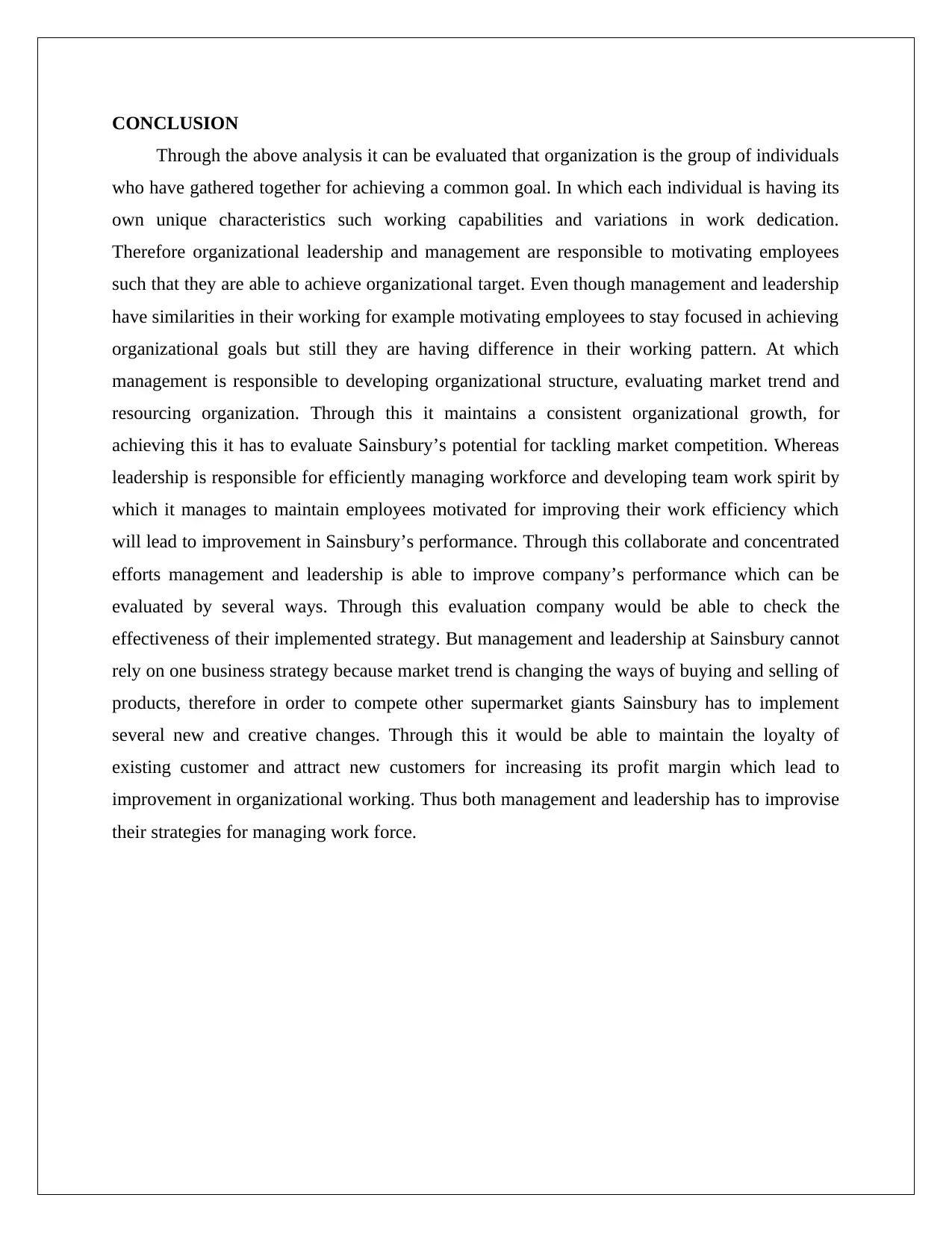
CONCLUSION
Through the above analysis it can be evaluated that organization is the group of individuals
who have gathered together for achieving a common goal. In which each individual is having its
own unique characteristics such working capabilities and variations in work dedication.
Therefore organizational leadership and management are responsible to motivating employees
such that they are able to achieve organizational target. Even though management and leadership
have similarities in their working for example motivating employees to stay focused in achieving
organizational goals but still they are having difference in their working pattern. At which
management is responsible to developing organizational structure, evaluating market trend and
resourcing organization. Through this it maintains a consistent organizational growth, for
achieving this it has to evaluate Sainsbury’s potential for tackling market competition. Whereas
leadership is responsible for efficiently managing workforce and developing team work spirit by
which it manages to maintain employees motivated for improving their work efficiency which
will lead to improvement in Sainsbury’s performance. Through this collaborate and concentrated
efforts management and leadership is able to improve company’s performance which can be
evaluated by several ways. Through this evaluation company would be able to check the
effectiveness of their implemented strategy. But management and leadership at Sainsbury cannot
rely on one business strategy because market trend is changing the ways of buying and selling of
products, therefore in order to compete other supermarket giants Sainsbury has to implement
several new and creative changes. Through this it would be able to maintain the loyalty of
existing customer and attract new customers for increasing its profit margin which lead to
improvement in organizational working. Thus both management and leadership has to improvise
their strategies for managing work force.
Through the above analysis it can be evaluated that organization is the group of individuals
who have gathered together for achieving a common goal. In which each individual is having its
own unique characteristics such working capabilities and variations in work dedication.
Therefore organizational leadership and management are responsible to motivating employees
such that they are able to achieve organizational target. Even though management and leadership
have similarities in their working for example motivating employees to stay focused in achieving
organizational goals but still they are having difference in their working pattern. At which
management is responsible to developing organizational structure, evaluating market trend and
resourcing organization. Through this it maintains a consistent organizational growth, for
achieving this it has to evaluate Sainsbury’s potential for tackling market competition. Whereas
leadership is responsible for efficiently managing workforce and developing team work spirit by
which it manages to maintain employees motivated for improving their work efficiency which
will lead to improvement in Sainsbury’s performance. Through this collaborate and concentrated
efforts management and leadership is able to improve company’s performance which can be
evaluated by several ways. Through this evaluation company would be able to check the
effectiveness of their implemented strategy. But management and leadership at Sainsbury cannot
rely on one business strategy because market trend is changing the ways of buying and selling of
products, therefore in order to compete other supermarket giants Sainsbury has to implement
several new and creative changes. Through this it would be able to maintain the loyalty of
existing customer and attract new customers for increasing its profit margin which lead to
improvement in organizational working. Thus both management and leadership has to improvise
their strategies for managing work force.
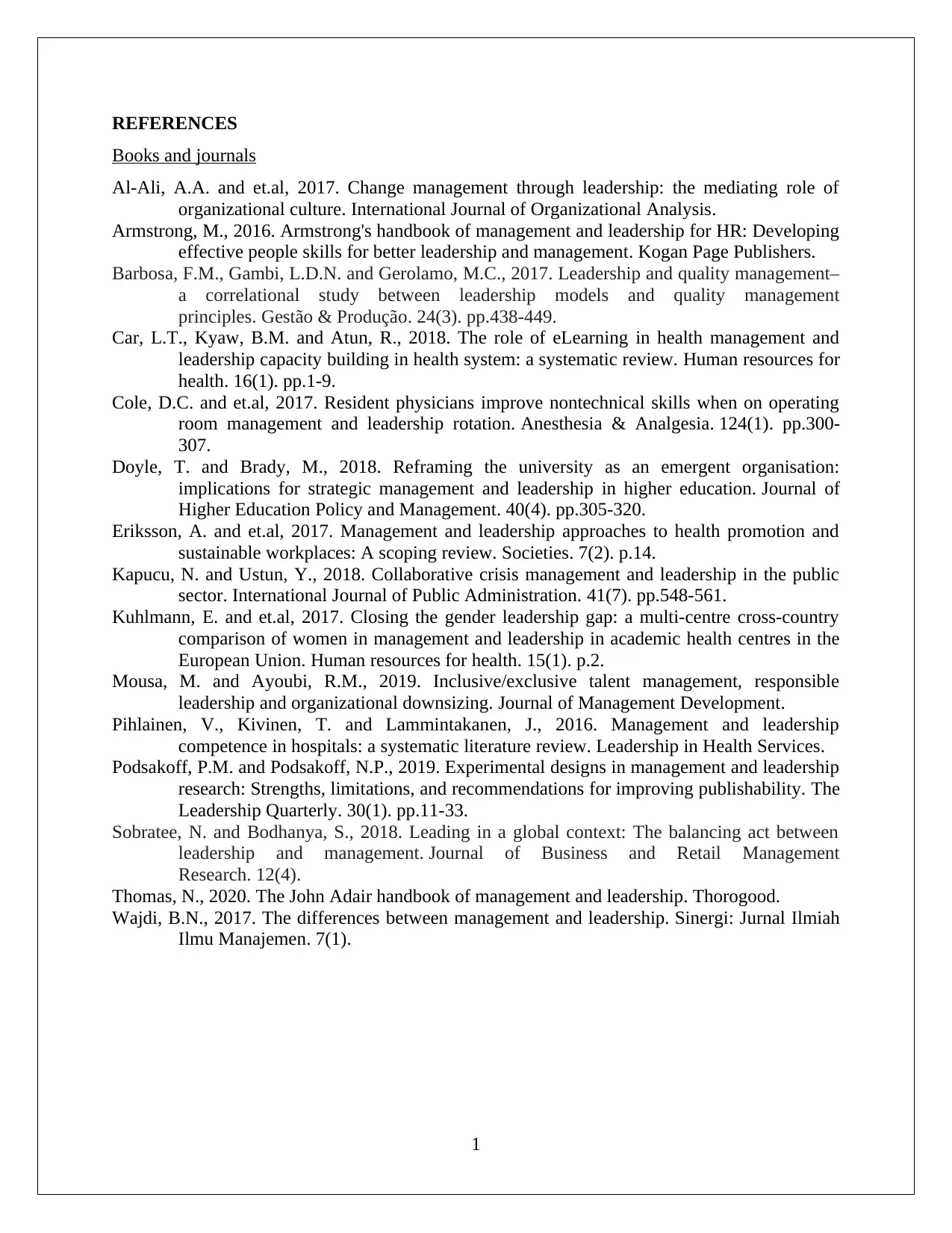
REFERENCES
Books and journals
Al-Ali, A.A. and et.al, 2017. Change management through leadership: the mediating role of
organizational culture. International Journal of Organizational Analysis.
Armstrong, M., 2016. Armstrong's handbook of management and leadership for HR: Developing
effective people skills for better leadership and management. Kogan Page Publishers.
Barbosa, F.M., Gambi, L.D.N. and Gerolamo, M.C., 2017. Leadership and quality management–
a correlational study between leadership models and quality management
principles. Gestão & Produção. 24(3). pp.438-449.
Car, L.T., Kyaw, B.M. and Atun, R., 2018. The role of eLearning in health management and
leadership capacity building in health system: a systematic review. Human resources for
health. 16(1). pp.1-9.
Cole, D.C. and et.al, 2017. Resident physicians improve nontechnical skills when on operating
room management and leadership rotation. Anesthesia & Analgesia. 124(1). pp.300-
307.
Doyle, T. and Brady, M., 2018. Reframing the university as an emergent organisation:
implications for strategic management and leadership in higher education. Journal of
Higher Education Policy and Management. 40(4). pp.305-320.
Eriksson, A. and et.al, 2017. Management and leadership approaches to health promotion and
sustainable workplaces: A scoping review. Societies. 7(2). p.14.
Kapucu, N. and Ustun, Y., 2018. Collaborative crisis management and leadership in the public
sector. International Journal of Public Administration. 41(7). pp.548-561.
Kuhlmann, E. and et.al, 2017. Closing the gender leadership gap: a multi-centre cross-country
comparison of women in management and leadership in academic health centres in the
European Union. Human resources for health. 15(1). p.2.
Mousa, M. and Ayoubi, R.M., 2019. Inclusive/exclusive talent management, responsible
leadership and organizational downsizing. Journal of Management Development.
Pihlainen, V., Kivinen, T. and Lammintakanen, J., 2016. Management and leadership
competence in hospitals: a systematic literature review. Leadership in Health Services.
Podsakoff, P.M. and Podsakoff, N.P., 2019. Experimental designs in management and leadership
research: Strengths, limitations, and recommendations for improving publishability. The
Leadership Quarterly. 30(1). pp.11-33.
Sobratee, N. and Bodhanya, S., 2018. Leading in a global context: The balancing act between
leadership and management. Journal of Business and Retail Management
Research. 12(4).
Thomas, N., 2020. The John Adair handbook of management and leadership. Thorogood.
Wajdi, B.N., 2017. The differences between management and leadership. Sinergi: Jurnal Ilmiah
Ilmu Manajemen. 7(1).
1
Books and journals
Al-Ali, A.A. and et.al, 2017. Change management through leadership: the mediating role of
organizational culture. International Journal of Organizational Analysis.
Armstrong, M., 2016. Armstrong's handbook of management and leadership for HR: Developing
effective people skills for better leadership and management. Kogan Page Publishers.
Barbosa, F.M., Gambi, L.D.N. and Gerolamo, M.C., 2017. Leadership and quality management–
a correlational study between leadership models and quality management
principles. Gestão & Produção. 24(3). pp.438-449.
Car, L.T., Kyaw, B.M. and Atun, R., 2018. The role of eLearning in health management and
leadership capacity building in health system: a systematic review. Human resources for
health. 16(1). pp.1-9.
Cole, D.C. and et.al, 2017. Resident physicians improve nontechnical skills when on operating
room management and leadership rotation. Anesthesia & Analgesia. 124(1). pp.300-
307.
Doyle, T. and Brady, M., 2018. Reframing the university as an emergent organisation:
implications for strategic management and leadership in higher education. Journal of
Higher Education Policy and Management. 40(4). pp.305-320.
Eriksson, A. and et.al, 2017. Management and leadership approaches to health promotion and
sustainable workplaces: A scoping review. Societies. 7(2). p.14.
Kapucu, N. and Ustun, Y., 2018. Collaborative crisis management and leadership in the public
sector. International Journal of Public Administration. 41(7). pp.548-561.
Kuhlmann, E. and et.al, 2017. Closing the gender leadership gap: a multi-centre cross-country
comparison of women in management and leadership in academic health centres in the
European Union. Human resources for health. 15(1). p.2.
Mousa, M. and Ayoubi, R.M., 2019. Inclusive/exclusive talent management, responsible
leadership and organizational downsizing. Journal of Management Development.
Pihlainen, V., Kivinen, T. and Lammintakanen, J., 2016. Management and leadership
competence in hospitals: a systematic literature review. Leadership in Health Services.
Podsakoff, P.M. and Podsakoff, N.P., 2019. Experimental designs in management and leadership
research: Strengths, limitations, and recommendations for improving publishability. The
Leadership Quarterly. 30(1). pp.11-33.
Sobratee, N. and Bodhanya, S., 2018. Leading in a global context: The balancing act between
leadership and management. Journal of Business and Retail Management
Research. 12(4).
Thomas, N., 2020. The John Adair handbook of management and leadership. Thorogood.
Wajdi, B.N., 2017. The differences between management and leadership. Sinergi: Jurnal Ilmiah
Ilmu Manajemen. 7(1).
1
⊘ This is a preview!⊘
Do you want full access?
Subscribe today to unlock all pages.

Trusted by 1+ million students worldwide
1 out of 14
Related Documents
Your All-in-One AI-Powered Toolkit for Academic Success.
+13062052269
info@desklib.com
Available 24*7 on WhatsApp / Email
![[object Object]](/_next/static/media/star-bottom.7253800d.svg)
Unlock your academic potential
Copyright © 2020–2025 A2Z Services. All Rights Reserved. Developed and managed by ZUCOL.





